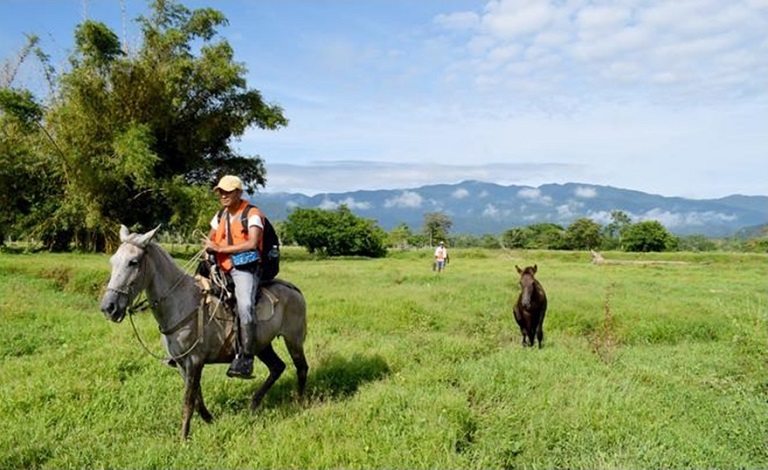BUSTING THE MYTHS OF SANTERIA — AND THEIR ANTI-BLACK ORIGINS
GUEST BLOGGER MAR 30, 2017
IDENTITIES
by Danielle Dorsey
Cuba was the first country I visited where I was able to blend in. Despite my modest Spanish skills, as long as I kept mum, locals assumed I was Afro-Cuban, and other tourists gravitated to paler, more familiar faces for translations and directions. For the first time in my life, I was able to enter rooms without sizing up and mentally calculating threats to my safety. I felt a kinship that I’d been searching for my entire life, and that propelled me to dig deeper into the rich Afro-Cuban culture.
Perhaps due to my own tendency toward mysticism and alternative spirituality, I found myself gravitating toward Santeria, as I called it then. I began soliciting advice from other tourists, but I soon learned that many harbored harmful misconceptions about the religion. One woman warned me not to make eye contact with the women adorned in white and told me that I would be cursed for doing so. Other tourists told me about guides who had refused to even step foot in related museums, fearful of what they believed to be “black magic.”
I attempted to ask locals, but the language barrier proved a hurdle. When I returned home, I scoured the internet for verifiable information, but came up short. Finally, I connected with T-D Gonzales, a priestess of Oshun for 18 years, and she was more than happy to fill in the gaps. Here are just several of the myth-busting facts that Gonzales revealed during our conversation:
1. “Santeria” is a misnomer.
My
Lonely Planet guidebook reserved only a small paragraph for Santeria and its mysteries, but it clarified that
Regla de Ocha is a more appropriate term. Gonzales explained that “Santeria” is a term most often used in the United States.
“Most people who practice the religion don’t call it Santeria, and many of us perceive that to be almost a pejorative term. Santeria alludes to the folk Catholicism of peasants and freed slaves. It also alludes to folk Catholicism of people who were perceived to be ignorant in Spain because of the undue emphasis that they appeared to place on the worship of saints. In the middle ages in Spain, a Santero was someone who was a carver of religious items, whereas in our context, people refer to Orisha priests as Santeros,” Gonzales said.
Regla de Ocha translates roughly to “Order of the Orishas,” and is often shortened to Ocha by practitioners. Many people in the religion also refer to themselves as Lucumi or say that they practice Lucumi religion, Yoruba worship, or Orisha worship.
2. Ocha and related Yoruba religions predate Abrahamic religions.
In fact, all traditional African religions predate Abrahamic faiths, and Orisha worship is just one of the many religions that was brought to the new world during the colonial era by enslaved Africans via the transatlantic slave trade. Yoruba is an ethnic group that originates from what we now call southwestern Nigeria and parts of Benin and Togo, and during the transatlantic slave trade they brought a number of distinct religions, spiritual and cultural practices. Ocha is just one of the religions that can be traced back to Yoruba land.
3. Ocha is not synonymous with witchcraft or black magic.
Santeria is a nature religion that involves working with medicinal herbs, and because of this, many assume that the practices are similar to witchcraft. It also involves divination, which many confuse with fortune telling.
Related: Oshun: The African Goddess Behind Beyonce’s Lemonade
Gonzales explained the difference, saying, “Divination practices are focused on our alignment with our higher selves and uncovering what our destinies are and how to ethically fulfill our destinies while we’re in this life.”
She said it’s a misconception that applies to many indigenous and African religions.
“I think people from the U.S. or other parts of Latin America tend to associate indigenous spiritual practices and African or Afro-Caribbean spiritual practices with witchcraft. For centuries in Cuba they just called it all
brujeria, or witchcraft, because anything that was not Christianity was considered witchcraft. So some people still have those kind of perceptions.”
And, for the record, the women dressed in white are novice priestesses and they are engaging in a year of purification as a commitment to their priesthood. They do not engage in cursing anyone and the very idea that they would is — as Gonzales so bluntly put it — absurd.
4. The secrecy surrounding Ocha is a preservation tactic.
As I discovered in my initial research, it’s fairly difficult to find information about the practices and beliefs of Ocha online. This traces back to Cuba’s colonial history, when enslaved people could be punished by death for worshipping outside of the Roman Catholic faith.
Limiting religious and cultural expression also helped colonizers keep control as they brought over countless numbers of enslaved people. Gonzales explained that, “They had to have very stringent controls over people and they perceived these enslaved people to be heathens, so any religious practices that were not in line with their beliefs were thought to be devil worship, when in actuality these religions don’t have any concept of a Satan or a devil. Those practices were outlawed and punishable by death sometimes. The drums, at many different points and times, were outlawed because they were used as communication between humans, but also as a way for humans to interact with Gods and to call the divine into human beings. All of that was grotesque and abominable to people who were not of that culture. Secrecy was essential to their survival. That carried forth and some concepts in the religion are simply secret. There’s a Yoruba word called
awo which means a mystery, and there are certain ritual secrets and mysteries that are only within the domain of an ordained priest and are not for general consumption or available to the general public.”
5. Homosexuality is more accepted, compared to many Abrahamic religions.
It’s sad how accustomed we’ve become to the pervasive homophobia associated with many religions. While it’s true that some denominations have become more accepting of various sexualities and gender identities, they still teach from a book that discourages those lifestyles. I was surprised to find out that, in many ways, Ocha is ahead of this curve.
“There is a place for everyone in Ocha, and there’s a long history of homosexual men and women. Some of the most prolific and famous priests in Cuba and Brasil have been gay and there’s certainly a place for them,” Gonzales assured me, before pointing out that, “It would be simplistic to say that it’s totally accepting of homosexuals, because there are some aspects of the religion that are absolutely forbidden to homosexual men and to women. Homosexuality is far more accepted and prevalent in Ocha, and more visible, compared to Abrahamic religions, but there are some aspects of the religion in which they are prohibited from engaging in.”
6. The reason why Orishas appear to have the traits of Catholic saints.
While I was in Cuba, I purchased some tile art of the Orisha Yemaya, who, as it was explained to me, corresponded archetypally to the Virgin Mary and represented the source of all waters. As I understood it, practitioners had once merged the traits of Orishas with Catholic saints in order to continue their worship in secret, but Gonzales quickly corrected that presumption.
“A common misconception is that the Yoruba people gave their Orishas the traits of Catholic saints in order to preserve their religion. These are syncretic religions, but they’re more syncretized with other African religions or with other European or the Latin form of Kardecian spiritism than with Catholicism. In the new world, towards the end of slavery and after slavery ended, free men were allowed to organize based on their ethnic groups, and those organizations were referred to as cabildos. Each ethnic group had its own organization that functioned under the auspices of a Catholic saint, because in the Spanish colonies everyone had to be Roman Catholic. There wasn’t a mixing per se of Yoruba religion with Catholicism, but there were simulation tactics that were employed that allowed the Africans to engage in their cultural activities under the auspices of worshipping a saint.”
Those who practiced Yoruba religions never confused the outward representations of Catholic saints with aspects of the Orishas, but the confusion became more common as Europeans began to get initiated.
7. Millions of people practice Ocha and related Yoruba worship around the world.
Don’t let the close-knit, protective nature of Ocha fool you into thinking that this religion is shrinking or limited to the Caribbean. Gonzales was gracious enough to invite me to a drumming ceremony when I expressed interest in learning more and, as she put it, “The religion is absolutely growing.”
This is partially due to the Cuban Revolution and the
Special Period, which created a Cuban diaspora.
There was joy in Gonzales’ voice as she spoke of how her religion has grown. “What began as an Afro-Cuban religion has become a universal religion with millions and millions of ordained priests all over the world.”
An hour into our conversation, we had still only scratched the surface of this complex religion. I’ll definitely think twice next time I find myself humming misguided Sublime lyrics.
Featured image, “Dance of Oshun,” by Byron Howes. Creative commons license.
Busting the Myths of Santeria - And Their Anti-Black Origins













